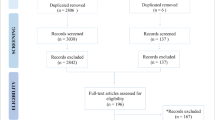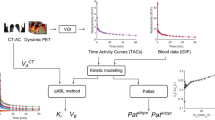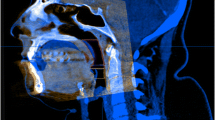Abstract
Purpose
To develop a novel non-invasive technique to quantify upper airway inflammation using positron emission tomography/magnetic resonance imaging (PET/MRI) in patients with obstructive sleep apnea (OSA).
Methods
Patients with treatment naïve moderate-to-severe OSA underwent [18F]-fluoro-2-deoxy-d-glucose (FDG) PET/MRI. Three readers independently performed tracings of the pharyngeal soft tissue on MRI. Standardized uptake values (SUV) were generated from region of interest (ROI) tracings on corresponding PET images. Background SUV was measured from the sternocleidomastoid muscle. SUV and target-to-background (TBR) were compared across readers using intraclass correlation coefficient (ICC) analyses. SUV from individual image slices were compared between each reader using Bland–Altman plots and Pearson correlation coefficients. All tracings were repeated by one reader for assessment of intra-reader reliability.
Results
Five participants completed our imaging protocol and analysis. Median age, body mass index, and apnea–hypopnea index were 41 years (IQR 40.5–68.5), 32.7 kg/m2 (IQR 28.1–38.1), and 30.7 event per hour (IQR 19.5–48.1), respectively. The highest metabolic activity regions were consistently localized to palatine or lingual tonsil adjacent mucosa. Twenty-five ICC met criteria for excellent agreement. The remaining three were TBR measurements which met criteria for good agreement. Head-to-head comparisons revealed strong correlation between each reader.
Conclusions
Our novel imaging technique demonstrated reliable quantification of upper airway FDG avidity. This technology has implications for future work exploring local airway inflammation in individuals with OSA and exposure to pollutants. It may also serve as an assessment tool for response to OSA therapies.




Similar content being viewed by others
Data availability
All imaging and statistical analyses are presented in the current study. Full dataset used for analyses can be made available on request.
Code availability
Not applicable.
Abbreviations
- AHI:
-
Apnea–hypopnea index
- BMI:
-
Body mass index
- CPAP:
-
Continuous positive airway pressure
- CT:
-
Computed tomography
- EDS:
-
Excessive daytime sleepiness
- EMR:
-
Electronic medical record
- ESS:
-
Epworth sleepiness scale
- FDG:
-
[18F]-fluoro-2-deoxy-d-glucose
- GFR:
-
Glomerular filtration rate
- HSAT:
-
Home sleep apnea testing
- ICC:
-
Intraclass correlation coefficient
- IQR:
-
Interquartile range
- MRI:
-
Magnetic resonance imaging
- OSA:
-
Obstructive sleep apnea
- PAT:
-
Peripheral arterial tonometry
- PET:
-
Positron emission tomography
- pRDI:
-
Peripheral arterial tonometry-respiratory disturbance index
- PSG:
-
Polysomnography
- ROI:
-
Region of interest
- SCM:
-
Sternocleidomastoid
- SUV:
-
Standardized uptake values
- TBR:
-
Target-to-background ratio
- TOF:
-
Time-of-flight
References
Senaratna CV, Perret JL, Lodge CJ et al (2017) Prevalence of obstructive sleep apnea in the general population: a systematic review. Sleep Med Rev 34:70–81. https://doi.org/10.1016/j.smrv.2016.07.002
Eckert DJ, Malhotra A (2008) Pathophysiology of adult obstructive sleep apnea. Proc Am Thorac Soc 5(2):144–153. https://doi.org/10.1513/pats.200707-114MG
Sekosan M, Zakkar M, Wenig BL, Olopade CO, Rubinstein I (1996) Inflammation in the uvula mucosa of patients with obstructive sleep apnea. Laryngoscope 106(8):1018–1020. https://doi.org/10.1097/00005537-199608000-00021
Kimoff RJ, Hamid Q, Divangahi M et al (2011) Increased upper airway cytokines and oxidative stress in severe obstructive sleep apnoea. Eur Respir J 38(1):89–97. https://doi.org/10.1183/09031936.00048610
Vicente E, Marin JM, Carrizo SJ et al (2016) Upper airway and systemic inflammation in obstructive sleep apnoea. Eur Respir J 48(4):1108–1117. https://doi.org/10.1183/13993003.00234-2016
Paulsen FP, Steven P, Tsokos M et al (2002) Upper airway epithelial structural changes in obstructive sleep-disordered breathing. Am J Respir Crit Care Med 166(4):501–509. https://doi.org/10.1164/rccm.2109099
Boyd JH, Petrof BJ, Hamid Q, Fraser R, Kimoff RJ (2004) Upper airway muscle inflammation and denervation changes in obstructive sleep apnea. Am J Respir Crit Care Med 170(5):541–546. https://doi.org/10.1164/rccm.200308-1100OC
Vogl TJ, Harth M, Siebenhandl P (2010) Different imaging techniques in the head and neck: assets and drawbacks. World J Radiol 2(6):224–229. https://doi.org/10.4329/wjr.v2.i6.224
Ehman EC, Johnson GB, Villanueva-Meyer JE et al (2017) PET/MRI: where might it replace PET/CT? J Magn Reson Imaging 46(5):1247–1262. https://doi.org/10.1002/jmri.25711
Ciscar MA, Juan G, Martinez V et al (2001) Magnetic resonance imaging of the pharynx in OSA patients and healthy subjects. Eur Respir J 17(1):79–86. https://doi.org/10.1183/09031936.01.17100790
Welch KC, Foster GD, Ritter CT et al (2002) A novel volumetric magnetic resonance imaging paradigm to study upper airway anatomy. Sleep 25(5):532–542
Schwab RJ, Pasirstein M, Pierson R et al (2003) Identification of upper airway anatomic risk factors for obstructive sleep apnea with volumetric magnetic resonance imaging. Am J Respir Crit Care Med 168(5):522–530. https://doi.org/10.1164/rccm.200208-866OC
Malhotra A, Huang Y, Fogel R et al (2006) Aging influences on pharyngeal anatomy and physiology: the predisposition to pharyngeal collapse. Am J Med 119(1):72.e9. https://doi.org/10.1016/J.AMJMED.2005.01.077
Moon IJ, Han DH, Kim J-W et al (2010) Sleep magnetic resonance imaging as a new diagnostic method in obstructive sleep apnea syndrome. Laryngoscope 120(12):2546–2554. https://doi.org/10.1002/lary.21112
Chi L, Comyn F-L, Mitra N et al (2011) Identification of craniofacial risk factors for obstructive sleep apnoea using three-dimensional MRI. Eur Respir J 38(2):348–358. https://doi.org/10.1183/09031936.00119210
Barrera JE (2011) Sleep magnetic resonance imaging: dynamic characteristics of the airway during sleep in obstructive sleep apnea syndrome. Laryngoscope 121(6):1327–1335. https://doi.org/10.1002/lary.21810
Kavcic P, Koren A, Koritnik B, Fajdiga I, Groselj LD (2015) Sleep magnetic resonance imaging with electroencephalogram in obstructive sleep apnea syndrome. Laryngoscope 125(6):1485–1490. https://doi.org/10.1002/lary.25085
Chiffer RC, Schwab RJ, Keenan BT, Borek RC, Thaler ER (2015) Volumetric MRI analysis pre- and post-transoral robotic surgery for obstructive sleep apnea. Laryngoscope 125(8):1988–1995. https://doi.org/10.1002/lary.25270
Feng Y, Keenan BT, Wang S et al (2018) Dynamic upper airway imaging during wakefulness in obese subjects with and without sleep apnea. Am J Respir Crit Care Med 198(11):1435–1443. https://doi.org/10.1164/rccm.201711-2171OC
Kubota R, Yamada S, Kubota K, Ishiwata K, Tamahashi N, Ido T (1992) Intratumoral distribution of fluorine-18-fluorodeoxyglucose in vivo: high accumulation in macrophages and granulation tissues studied by microautoradiography. J Nucl Med 33(11):1972–1980
Gotthardt M, Bleeker-Rovers CP, Boerman OC, Oyen WJG (2010) Imaging of inflammation by PET, conventional scintigraphy, and other imaging techniques. J Nucl Med 51(12):1937–1949. https://doi.org/10.2967/jnumed.110.076232
Torigian DA, Zaidi H, Kwee TC et al (2013) PET/MR imaging: technical aspects and potential clinical applications. Radiology 267(1):26–44. https://doi.org/10.1148/radiol.13121038
Shih I-L, Wei S-C, Yen R-F et al (2018) PET/MRI for evaluating subclinical inflammation of ulcerative colitis. J Magn Reson Imaging 47(3):737–745. https://doi.org/10.1002/jmri.25795
Nensa F, Beiderwellen K, Heusch P, Wetter A (2014) Clinical applications of PET/MRI: current status and future perspectives. Diagnostic Interv Radiol 20(5):438–447. https://doi.org/10.5152/dir.2014.14008
Kuhn FP, Hüllner M, Mader CE et al (2014) Contrast-enhanced PET/MR imaging versus contrast-enhanced PET/CT in head and neck cancer: how much MR information is needed? J Nucl Med 55(4):551–558. https://doi.org/10.2967/jnumed.113.125443
Cavaliere C, Romeo V, Aiello M et al (2017) Multiparametric evaluation by simultaneous PET-MRI examination in patients with histologically proven laryngeal cancer. Eur J Radiol 88:47–55. https://doi.org/10.1016/j.ejrad.2016.12.034
Kim AM, Keenan BT, Jackson N et al (2014) Metabolic activity of the tongue in obstructive sleep apnea. A novel application of FDG positron emission tomography imaging. Am J Respir Crit Care Med 189(11):1416–1425
Kundel V, Trivieri MG, Karakatsanis NA et al (2018) Assessment of atherosclerotic plaque activity in patients with sleep apnea using hybrid positron emission tomography/magnetic resonance imaging (PET/MRI): a feasibility study. Sleep Breath 22(4):1125–1135. https://doi.org/10.1007/s11325-018-1646-2
Johns MW (1991) A new method for measuring daytime sleepiness: the Epworth sleepiness scale. Sleep 14(6):540–545
Yalamanchali S, Farajian V, Hamilton C, Pott TR, Samuelson CG, Friedman M (2013) Diagnosis of obstructive sleep apnea by peripheral arterial tonometry. JAMA Otolaryngol Neck Surg 139(12):1343. https://doi.org/10.1001/jamaoto.2013.5338
Ng S, Chan T, To K et al (2010) Validation of Embletta portable diagnostic system for identifying patients with suspected obstructive sleep apnoea syndrome (OSAS). Respirology 15(2):336–342. https://doi.org/10.1111/j.1440-1843.2009.01697
Pittman SD, Ayas NT, MacDonald MM, Malhotra A, Fogel RB, White DP (2004) Using a wrist-worn device based on peripheral arterial tonometry to diagnose obstructive sleep apnea: in-laboratory and ambulatory validation. Sleep 27(5):923–933. https://doi.org/10.1093/sleep/27.5.923
Bland JM, Altman DG (1986) Statistical methods for assessing agreement between two methods of clinical measurement. Lancet (London, England) 1(8476):307–310
Nakamoto Y, Tatsumi M, Hammoud D, Cohade C, Osman MM, Wahl RL (2005) Normal FDG distribution patterns in the head and neck: PET/CT evaluation. Radiology 234(3):879–885. https://doi.org/10.1148/radiol.2343030301
Wang Y, Chiu E, Rosenberg J, Gambhir SS (2007) Standardized uptake value atlas: characterization of physiological 2-deoxy-2-[18F]fluoro-d-glucose uptake in normal tissues. Mol Imaging Biol 9(2):83–90. https://doi.org/10.1007/s11307-006-0075-y
Schwarz EI, Puhan MA, Schlatzer C, Stradling JR, Kohler M (2015) Effect of CPAP therapy on endothelial function in obstructive sleep apnoea: a systematic review and meta-analysis. Respirology 20(6):889–895. https://doi.org/10.1111/resp.12573
Mehra R, Benjamin EJ, Shahar E et al (2006) Association of nocturnal arrhythmias with sleep-disordered breathing. Am J Respir Crit Care Med 173(8):910–916. https://doi.org/10.1164/rccm.200509-1442OC
Gottlieb DJ, Yenokyan G, Newman AB et al (2010) Prospective study of obstructive sleep apnea and incident coronary heart disease and heart failure. Circulation 122(4):352–360. https://doi.org/10.1161/CIRCULATIONAHA.109.901801
Peker Y, Glantz H, Eulenburg C, Wegscheider K, Herlitz J, Thunström E (2016) Effect of positive airway pressure on cardiovascular outcomes in coronary artery disease patients with nonsleepy obstructive sleep apnea. The RICCADSA Randomized Controlled Trial. Am J Respir Crit Care Med. 194(5):613–620. https://doi.org/10.1164/rccm.201601-0088OC
Young T, Finn L, Peppard PE et al (2008) Sleep disordered breathing and mortality: eighteen-year follow-up of the Wisconsin sleep cohort. Sleep 31(8):1071–1078
Marshall NS, Wong KKH, Cullen SRJ, Knuiman MW, Grunstein RR (2014) Sleep apnea and 20-year follow-up for all-cause mortality, stroke, and cancer incidence and mortality in the Busselton health study cohort. J Clin Sleep Med 10(4):355–362. https://doi.org/10.5664/jcsm.3600
de la Peña Bravo M, Serpero LD, Barceló A, Barbé F, Agustí A, Gozal D (2007) Inflammatory proteins in patients with obstructive sleep apnea with and without daytime sleepiness. Sleep Breath. 11(3):177–185. https://doi.org/10.1007/s11325-007-0100-7
DeMartino T, El GR, Wang L et al (2016) Oxidative stress and inflammation differentially elevated in objective versus habitual subjective reduced sleep duration in obstructive sleep apnea. Sleep 39(7):1361–1369. https://doi.org/10.5665/sleep.5964
Li Y, Vgontzas AN, Fernandez-Mendoza J et al (2017) Objective, but not subjective, sleepiness is associated with inflammation in sleep apnea. Sleep 40(2):zsw033. https://doi.org/10.1093/sleep/zsw033
Heusch P, Buchbender C, Beiderwellen K et al (2013) Standardized uptake values for [18F] FDG in normal organ tissues: comparison of whole-body PET/CT and PET/MRI. Eur J Radiol 82(5):870–876. https://doi.org/10.1016/j.ejrad.2013.01.008
Iagaru A, Mittra E, Minamimoto R et al (2015) Simultaneous whole-body time-of-flight 18F-FDG PET/MRI: a pilot study comparing SUVmax with PET/CT and assessment of MR image quality. Clin Nucl Med 40(1):1–8. https://doi.org/10.1097/RLU.0000000000000611
Jadvar H, Colletti PM (2014) Competitive advantage of PET/MRI. Eur J Radiol 83(1):84–94. https://doi.org/10.1016/j.ejrad.2013.05.028
Broski SM, Goenka AH, Kemp BJ, Johnson GB (2018) Clinical PET/MRI: 2018 update. Am J Roentgenol 211(2):295–313. https://doi.org/10.2214/AJR.18.20001
Mehranian A, Zaidi H (2015) Impact of time-of-flight pet on quantification errors in MR imaging-based attenuation correction. J Nucl Med 56(4):635–641. https://doi.org/10.2967/jnumed.114.148817
Ziai P, Hayeri MR, Salei A et al (2016) Role of optimal quantification of FDG PET imaging in the clinical practice of radiology. Radiographics 36(2):481–496. https://doi.org/10.1148/rg.2016150102
Acknowledgements
Support for this study was provided by the American Academy of Sleep Medicine Foundation through a Focused Project Award (126-FP-15) to Dr. Neomi Shah.
Funding
The study was funded by an American Academy of Sleep Medicine Foundation Focused Project Award (126-FP-15) to Dr. Shah. Dr. Shah also has funding from the National Institute of Health/National Heart, Lung, and Blood Institute (1R01HL143221-01). Dr. Cohen has funding from the American Thoracic Society’s ASPIRE Fellowship.
Author information
Authors and Affiliations
Contributions
All authors contributed meaningfully to this work. All authors have seen and approved this manuscript for publication.
Corresponding authors
Ethics declarations
Ethics approval
The study was approved by the Institutional Review Board at the Icahn School of Medicine at Mount Sinai.
Consent to participation and publication
All participants provided written informed consent.
Conflict of interest
The authors declare no competing interests.
Additional information
Publisher's note
Springer Nature remains neutral with regard to jurisdictional claims in published maps and institutional affiliations.
Supplementary Information
Below is the link to the electronic supplementary material.
Rights and permissions
About this article
Cite this article
Cohen, O., John, M.M., Kaufman, A.E. et al. Novel non-invasive assessment of upper airway inflammation in obstructive sleep apnea using positron emission tomography/magnetic resonance imaging. Sleep Breath 26, 1087–1096 (2022). https://doi.org/10.1007/s11325-021-02480-3
Received:
Revised:
Accepted:
Published:
Issue Date:
DOI: https://doi.org/10.1007/s11325-021-02480-3




